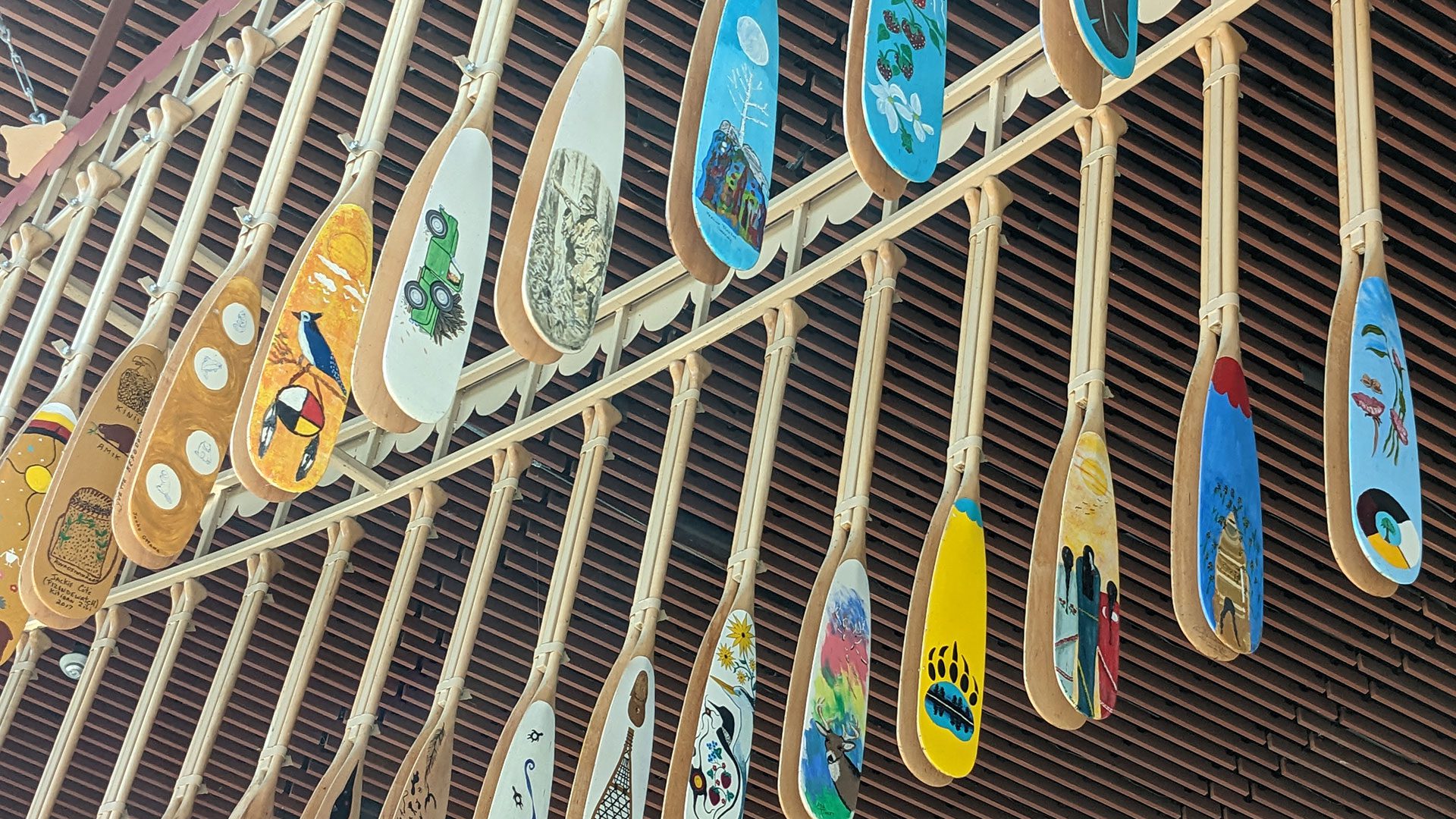
An artists drawing of the new Ottawa Public Library and National Archives in Ottawa.
Officials overseeing the development of Ādisōke, the new Ottawa Library and National Archives say 11 First Nation, Inuit and Métis artists are being commissioned to provide artwork for the building.
At the moment the building, located on the western edge of the downtown core, is still under construction.
“When we got that first call it was almost unbelievable. It’s the biggest opportunity we have gotten together,” says artist Claire Brascoupé who was one of the many artists APTN News spoke with.
“We had been shortlisted so we knew a decision would be coming. It was exciting to find out we would be included.”
Claire, along with sisters Emily and Mairi, are from Kitigan Zibi Anishinābeg located 150 km north of Ottawa, are all based in Ottawa and will produce artwork for the interior and exterior windows for Ādisōke.
They currently also have works at the Pimisi station of Ottawa’s light rail transit station the Bytowne Museum.
“We had an opportunity to meet with many Algonquin Elders as a part of this process. They gave us little details that I think really add to the final pieces,” says Emily Brascoupé-Hoefler
“It’s always emotional to see your work, one of the pieces is huge, and I think it’s going to be exciting to see it finished, in the space, will be exciting.”

Adding another layer to the excitement is where the art will be displayed.
“It’s also great that it’s on our home territory, in our hometown,” says Mairi Brascoupé.
Working together as Three Sister Art Collective the siblings are proud to be a part of such a big piece of the city.
“Through our work, we want to share our culture and to have Algonquin storytelling and art have its pride of place on unceded Algonquin Territory, says Claire Brascoupé.
Katherine Takpannie is a photographer whose family is from Nunavut. Takpannie was born in Montreal, lives Ottawa and says she’s a member of the “Millenial Scoop.”
She says she’s new to the photography scene and says she was surprised that she was chosen.
“In 2021 when the first callouts happened, I was just emerging, but I thought, I’ll just go for it,” she says. “It’s one of those things you shoot for the stars, I didn’t expect to be chosen.”
When asked about the significance of the work she is doing for Ādisōke she says, “It’s very important to tell the world who we [Inuit] are. I’ve met folks who still think we live in Igloos, there’s a severe lack of education. It’s extremely important to have a voice in this land that we share.”
Ādisōke means the telling of stories in Anishinābemowin
According to the Ādisōke website, the name was chosen after consultation with members of the Kitigan Zibi Anishinābeg, the Algonquins of Pikwakanagan First Nation and with representatives of the Ottawa Public Library and Library and Archives Canada.
In a statement on the website, Della Meness, education minister for Pikwakanagan said, “Adisoke represents partnership, commitment and respect.”
Engagement between the two communities closest to the site, the architect, Diamond Schmitt, and the Ottawa Public Library Project Team, began early in the planning stages of the project.
The level of consultation with local communities was what drew art curator and member of the Métis Nation of Alberta, Dawn Saunders Dahl, to accept the position as the curator of Indigenous Art for Ādisōke.
“I was asked to participate as a curator and what lured me was the fact the Ottawa Public Art team and the architect, Diamond Schmitt had already been doing a lot of local community Indigenous consultation,” says Saunders Dahl.
“I’ve been working in public art for a number of years and to see such a large facility consider that and make sure it layered into the plan before drawings were made, to me that was a huge plus. That’s what should happen.”

The $334 million project will house the Ottawa Public Library, the National Archives, a genealogy centre, a maker space, a preservation library, a music rehearsal room complete with an instrument library, an auditorium and an Indigenous circular lodge amongst its many other spaces.
“Art presents a space where people feel more comfortable sharing stories as well as understanding,” says Saunders Dahl.
“Having genealogy records and archives and a public library in one spot—encourages people to research and understand different perspectives.”
Covering five floors and occupying more than 20,100 square meters (216,000 square feet) the contemporary facility is scheduled to open in 2026.
Presently, the building is up, and the floors have been poured. In 2024 there will be public engagement on programs and services and 2025 will see equipment and furniture brought in and installed.
The central branch on Metcalfe St. will remain open until the new location opens.
According to all the artists APTN spoke with, the application process was long, involving many steps such as an expression of interest, a current CV, a detailed proposal, technical information, budget, and scheduling to name a few.
“At the time, [of the application] I was taking a university course titled, Public Art. In this course, and as an assignment, we were required to create a proposal package in response to an actual Request for Proposals,” says Dee Barsy a painter from Skownan First Nation.
“After submitting my assignment to the professor, I thought, ‘Why don’t I just submit this for real?’ I did not believe that I would get shortlisted! After I was shortlisted, I was invited to do an interview.
“I felt so proud of myself for doing something outside my comfort zone. It was a huge confidence boost,” she says.
Video courtesy Pat Lescard/Ottawa Freelance Photography.
Mary Anne Barkhouse from ʼNa̱mǥis First Nation has been chosen to make sculptures for the exterior of the building.
A descendant of the famous wood carver, Mungo Martin, Barkhouse is a sculptor who uses bronze as a medium.
“Although my work uses different materials [than Martin] and is in a more contemporary style, I think we all share this role of visual storyteller,” she says.
“While I love working with bronze for my installations, and Mungo, Charlie and Ellen would have been working with cedar, and we each tell the stories of our own times in our own way, nevertheless I think there is a continuum … our stories are all grounded in issues around community and land and that hasn’t changed.”
The artists were not able to reveal details of their pieces to APTN but Saunders Dahl, hinted, “Themes of environment and forests, water, animals and the stories surrounding them seem to be bubbling up in the artwork.
“I hope it’s an amazing example of what other places could be doing when they build these big facilities. Here is how you can thoughtfully consult with Indigenous people in that process.”
A full list of the artists producing pieces for Ādisōke can be found on their website.









